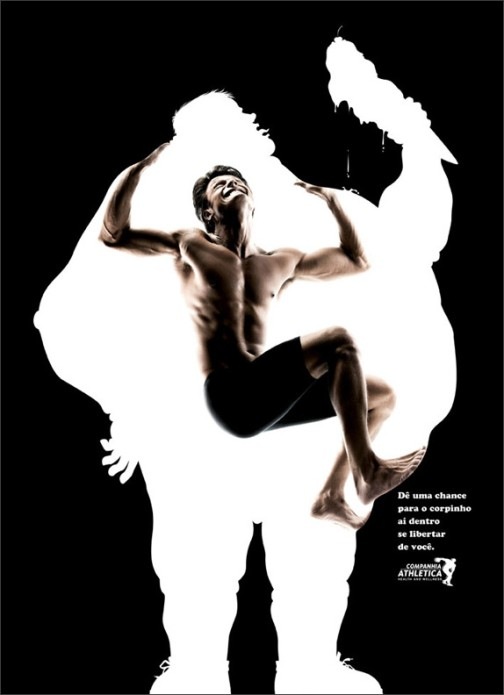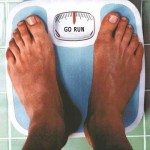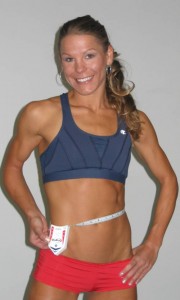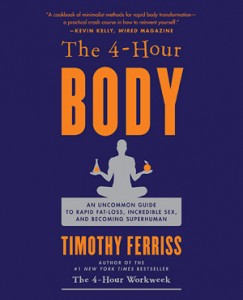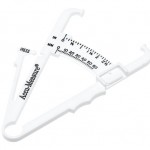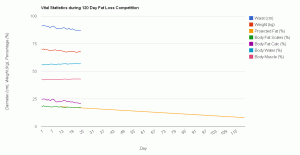120 Day Fat Loss / Muscle Gain Competition
On this page:
- Welcome
- Getting started
- Body weight is not enough
- What to measure for the competition?
- How often to measure?
- Tools to help you track your diet and exercise
- Connect with each other
- Contribute!
- DISCLAIMER
Welcome
Thank you all for joining the 120 Day Fat Loss or 120 Day Muscle Gain Competitions. That’s right there are two categories… I started with the idea of doing a 120 Day Fat Loss Competition following the festive period but the first person to respond to my Facebook invite was Tsvetan who was more interested in gaining muscle rather than burning fat. So if you haven’t already joined but are interested in burning fat or are more focused on gaining muscle, join us and compete with us to see who can make the most gains over a 120 day period.
Towards the end of January 2011 more than 40 people are participating! What a great response! Welcome and thank you for taking part!
Getting started
Some of you may have agreed to take part or were thinking of taking part but haven’t yet committed. In that case, if you needed a little encouragement, then here it is! Join us! It will be lots of fun. You can benefit from the competitive spirit or from the sense of community to help propel you towards your goals for your physique.
Body weight is not enough
Usually people track their overall weight when trying to lose fat. The problem with this approach is that body weight is composed of many things e.g. fat, organs, muscle, water, bones etc. When people say they want to lose weight, in most cases what they mean is that they want to burn the excess fat. Body muscle is good, while excess fat is bad. There are many ways of losing weight. We want to avoid ways that will eat away at our body’s muscle. Instead we want to focus on losing excess fat whilst keeping or gaining on our muscle.
What to measure for the competition?
For this competition I’d like you to track 3 things which will give us an overall picture of how your body is changing over the 120 day period:
- Your weight in kilograms (kg)
- The diameter of your waist in centimetres (cm)
- An estimate of your body fat in percentage (%)
Using bathroom scales to measure your weight
This measurement has been a standard that we have all measured all our lives. As you’re probably weighing yourself anyway we may as well track this as usual in the spreadsheet. This spreadsheet is only visible to participants who have received an invite via email. If you’re participating but don’t yet have access send your email address to either myFacebook inbox or mail me ali.m.zaidi [at] gmail [dot] com.
To get consistent reliable results I recommend weighing yourself with no clothes on, at the same time of day in similar conditions. I for example weigh myself in the morning 30 minutes after drinking a litre of water and relieving myself. If on one day you were to weigh yourself on an empty stomach with no clothes on and then the next time you weighed yourself with winter clothes and boots on after just having consumed a 2kg steak – you would obviously weigh more on the second day…
How to measure your waist size?
Why am I asking participants of the fat loss competition to track their waste size as well as body fat percentage? Like me a lot of you will be using Bioelectric Impedance Scales to estimate your body fat. These are great for convenience, but unless you have a high end one it most likely will not be taking your visceral fat into account as much as one would like it to. Visceral fat is in the abdominal region. Over the last few weeks I have been tracking both my waist and body fat percentage via a BIA (Bioelectric Impedance Analysis) Body Fat scale. Sometimes I’ve noticed that I feel thinner, though when I measure myself on the scale it hasn’t shown a drop in bodyfat percentage. But then I measure my waist size I notice a drop in centimetres. This shows to me the possibility that I may have lost belly fat but the BIA scale hasn’t picked up on it yet. By including waist size in your tracking you will get a broader picture of how your body is responding to your change in lifestyle.
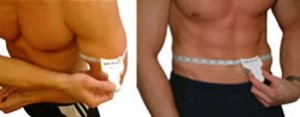
Use an Accu-Measure MyoTape to accurately and easily measure your waist, bicep or any other part of your body
To measure your waste size you can either use an ordinary tape measure or you can use an OrbiTape from Amazon.co.uk | (Amazon.com)
or an MyoTape from Amazon.co.uk
| (Amazon.com)
. I’ve just ordered both from Amazon to see which is better – a more detailed blog post on this topic coming later! These products allow for an accurate measure of different parts of the body without the need for someone else to help you measure yourself. They’re great for single people! They also cause a standard tension in the tape, so there is no more cheating involved by subconsciously holding the tape measure too tightly in order to improve your results!
I’ve tried to find the best place to measure the waist. Some people say about a centimetre above the belly button, others say one centimetre below the navel, while others still, recommend around the belly button itself. I personally measure about a centimetre below the belly button. It’s up to you to choose how you want to do it. Just make sure each time you do it you do it at the same place in order to be consistent and get a better idea of your progress.
How to measure your body fat percentage?
I leave this decision totally up to you. Choose whatever works best for you. In this section I will explore some of the methods available.
So what’s the best way to measure body fat? Well there are many ways. The problem with all methods is that they are only estimates. I personally think the only reliable way to really know how much fat there is in your body is to have yourself dissected; have all the fat removed; placed on a super accurate scale in a vacuum and then weighed. As none of us want to be dissected any time soon, all we can do is go by estimates. Some methods of estimation are more accurate than others. But the more accurate methods also cost a lot more.
The more expensive, less convenient ways to get a body fat percentage estimate
The more expensive methods (but probably more reliable) are:
- Ultrasound / BodyMetrix (over £2000 for the kit)
- BodPod – Middlesbrough Football Club has one. Sessions can be arranged from £30 per session.
- Underwater Weighing – used to be the “Gold Standard” for estimating body fat percentage
- DEXA (Dual Energy X-ray Absorptiometry) – is increasingly being considered the “Gold Standard” and can cost from £137 per session with a Doctor’s referral
- X-ray CT
- MRI
The cheaper, more convenient methods of bodyfat percentage measurements
The cheaper methods include:
BIA (Bioelectrical Impedance Analysis) Scales
I find this the most convenient way of getting a body fat percentage estimate. If you get the right model it can act like a bathroom scale (therefore also give you your weight) whilst giving you estimates for body composition (body fat, body muscle and body water). I use a body fat scale I bought from Wilkinson on a whim. I walked past it, thought wow and just bought one. I didn’t do any research into it before buying it. If I had, I would have probably gone for a Tanita model. Tanita were the first company in the world to invent a weight scale plus body fat measurement in 1992. Tanita also supply hospitals with similar technology. It seems to me that their products may well be better than the rest. I haven’t tried one myself though so I can’t vouch for them on the basis of personal experience. They have some advanced models which can go so far as to tell you the body fat composition in different parts of your body as well as a visceral fat reading (abdominal reading). The Tanita BC545 Glass Electronic Bathroom Scale with Body Fat Analyser from Amazon.co.uk | Amazon.com
model is currently on offer at Amazon and is down from the original price of £199.00 to £154.62. It doesn’t just put an electric current through your feet, but also your hands so that it can also give you a visceral fat reading! Awesome!
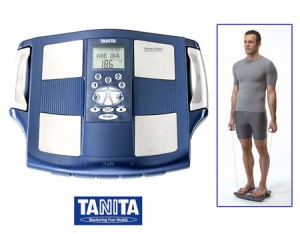
The Tanita BC545 Advanced BIA (Bioelectrical Impedance Analysis) Scales sends electricity through your hands as well as your feet to give you a segmented body fat reading including visceral fat
Other cheaper options include Wilkinson (where I got mine from) or as suggested by Zar Yusaf, Argos. I personally wouldn’t recommend Argos as I have boycotted them for appalling customer service and inaccurate website. But as Zar has taken the time to share the link with participants of this competition on my Facebook Wall I’ve shared the link onto you!
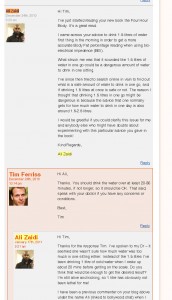
Timothy Ferris 4-Hour Body BEI (Bioelectrical Impedance Analysis) recommendation to drink 1.5 litres of water 30 minutes before using scale
Again with this method of body fat measurement estimation I recommend keeping things consistent. Measure at the same time of day, and make sure your hydration is similar each time you measure too. In order to keep consistent hydration Timothy Ferris in his book The 4-Hour Body: An uncommon guide to rapid fat-loss, incredible sex and becoming superhuman: The Secrets and Science of Rapid Body Transformation on Amazon.co.uk | Amazon.com
(currently on sale for half price via the links I just provided) recommends drinking 1.5 litres of water first thing in the morning, waiting 30 minutes, taking a pee and then getting on the BIA scales. I was a bit concerned about drinking so much in one sitting – I didn’t want to drown my body with too much water (as tragically happens with some ecstasy pill consumers). After speaking to my doctor and double checking with Timothy Ferris via his blog – I’ve been drinking 1 litre of water rather than the 1.5 litre and the technique still seems to work well for me.
Callipers / Calipers
You may decide that you would prefer the use of callipers to estimate body fat percentage. It’s best to have a professional do this for you, or get callipers that are designed for self assessment like the Accu Measure Fitness 3000 Personal Body Fat Tester on Amazon.co.uk | Amazon.com
. Like cheap BIA scales the drawback to this method is that it won’t take into account your visceral fat – where a lot of us tend to deposit our fat!
Bodyfat percentage calculation
A completely free way to get a body fat estimate is to use the webpage shared by Sohail Anwar on my Facebook Wall. All you need is a bathroom scale to measure your weight and a tape measure to measure your height and waist. You input the data into the web form and hit the “Calculate!” button. And just like magic it gives you a body fat percentage estimate along with other stats. To convert kilograms into lbs for the web page use Google. Likewise, to convert centimetres into inches use Google! Don’t you just LOVE Google!
I personally use a BIA Scale, a tape measure to measure my waist and this calculation on a daily basis. I find doing this gives me far more insight into how my body is behaving. The great thing about this calculation is that it is highly sensitive to the fluctuation in waist size i.e. visceral / abdominal fat. Sometime I find that my scales have not picked up a drop in body fat, yet my waist size has decreased and I feel thinner too – and this calculation picks up on it. You cansee my daily spreadsheet and a graph of all the factors I am tracking below. I highly recommend doing yourself a graph like this as it helps you visualise your progress – (very good for motivation!). Head over to Google Docs and sign up for a FREE account and set yourself a spreadsheet! Also if you haven’t done so already start tracking your weekly progress on the spreadsheet I have designed for the participants of this competition (message me for access!).
How often to measure?
Bare minimum to be part of the 120 Day Fat Loss / Muscle Gain Competition
For the purpose of this competition you need to measure yourself at least once at the beginning and once at the end of the 120 days.
For the Google Docs Spreadsheet
However I encourage you to measure and track your progress at least once a week on the spreadsheet designed specifically for this competition. It’s really easy. I’ve already entered your name and designed the rows and columns. All you need to do is start entering your data. You will find that it WILL motivate you immensely to see your progress compared to other participants. At some point I will also allow the spreadsheet to create a chart so that you can see your progress in a graphical format. If you’ve only been measuring your weight, or body fat – it’s not too late to start tracking your waist size too. Start doing it today. You won’t regret the enhanced insights you will gain about your own body! I promise!
The best option is to track your progress every day!
I personally measure myself everyday and you can follow my progress via this spreadsheet. I find that the more often I track my progress the more insight I get into how my body responds to different things (food, exercise etc) and highly recommend you do the same.
If you need help with either the weekly spreadsheet, or creating your own daily tracking spreadsheet – just give me a shout and I’ll be happy to help!
Your chance to be part of an academic study
Eddie Bradley is a researcher at Durham University and is interested in using the data we collect to potentially write an academic paper on the results we achieve. Here’s a message from Eddie describing the kind of information he would like from us:
Hi.
If possible it would be good to get a measure of weight (kg) every week, including initial and final. Also a measure of body fat % once a month.
If this can be recorded in excel or something similar and then collected after 2 months and at the end.
Alongside these measures, can you record a general outline of what you have done each week to lose weight/fat. This does not have to be in great detail, more along the lines of what diet you have been using or type of exercise and overall durations. This can be recorded as a short summary in word and collected as with the above data.
Thanks
Eddie Bradley
If you have any queries in regards to the paper please contact Eddie at: eddiebradley [at] gmail [dot] com.
If you track your progress weekly on the spreadsheet I’ve provided, half of what you need to track for the paper will already be done. All you’ll need to do on top of that is keep a track of what you’re doing in terms of diet and exercise to achieve the results you’re getting.
Tools to help you track your diet and exercise
To help you track what you’re doing you can do the following:
- Blog like me and Tvsetan: You can get a free blogging account at WordPress, Blogger, or blog.com
- Start a fitness, exercise and nutrition journal: Hamzah Malik recommends Body Space. I tried Fitday last year. I found it a little time consuming but worthwhile. It’s also fantastic for tracking the nutrients you take in every day – to see if you’re nourishing your body properly. Others to consider include: MyFitnessPal, Spark People,DailyBurn and loads of others (just Google: “free fitness and nutrition journal”)
Connect with each other
You can connect with other participants of the 120 Fat Loss Competition or 120 Day Muscle Gain Competition via:
- The 120 Fat Loss Competition / 120 Day Muscle Gain Competition Facebook EVENT Page
- I’ve just set up the 120 Fat Loss Competition / 120 Day Muscle Gain competition Facebook FAN Page where there is a discussion forum for participants to share tips, gloat about progress and egg each other on.
Contribute!
Would you like to contribute to the group? I’m looking for guest bloggers (participants or non-participants). Were you once fat or chubby and now have the body of an Olympian god / goddess? If so, share your experience, inspiration and tips with the group. Are you a personal trainer? Are you a fitness freak? Are you a reservoir of knowledge on nutrition and health? Are you a power-lifting or bodybuilding champion? If so, I’d like hear from you! We can do with all the tips, tricks and long term health advice we can get! Leave me a comment below and let’s get the ball rolling…
As participants you can also contribute by sharing information and support on the Facebook Events and Facebook Fan page. Paul Higgs recently offered participants a free e-book on burning fat. Contact Paul on Facebook for the free booklet.
DISCLAIMER: I’ve started this competition in good faith. I realised the New Year was coming up and Christmas had just passed and I knew people would be making New Year Resolutions to get fit. I thought I and others could increase our motivation and resilience by starting a competition that lasted for a significant period of time. If we keep at it for the 120 days we’ll be in much better shape for May… just as Summer will be starting. Please don’t be stupid like the “Hold Your Wee for a Wii” woman and kill yourself trying to win the competition! Also if you see any advice on this site check with your Doctor first if you are in doubt. And please don’t sue me if things go wrong! :-p Other than that best of luck! ![]()
